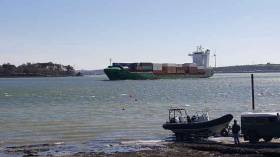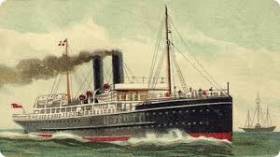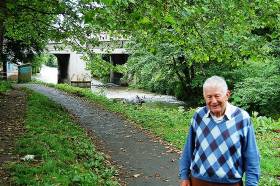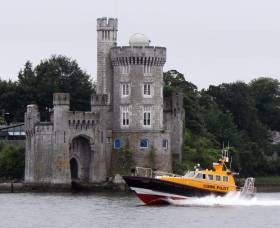Displaying items by tag: Island Nation
'Let Us Benefit From Being an Island Nation'
The Managing Director of one of the biggest fishermen’s co-operatives in the country has criticised French fishermen who have tried to impose a boycott on the sales of imported fish. The Scottish fishing industry has also made complaints.
“They like to declare European waters when they have 50 per cent of the monkfish quota in Irish waters, while Ireland gets just 5 per cent of the monkfish quota in our own waters,” says John Nolan, Managing Director of Castletownbere Fishermen’s Co-op. “But they don’t like to accept that there is a European market to which we have equal access.”
"Ireland gets just 5 per cent of the monkfish quota in our own waters"
THE ECHO Cork reports that he says French fishermen “have been taking television crews to wholesale and processing operations which they accused of buying fish from non/French boats and not supporting their own industry. People are afraid actually in France to take fish off us. Even big supermarkets like Leclerc, even their government is saying only buy French fish. It does get annoying when you see the way the French are acting. You get this parochialism coming in and the French fishermen going around, they don’t want a European market, but they do want our waters to be European for them. I’m disappointed with that attitude.”
More on THE ECHO which, in a leading article today headed: “Island nation - let us benefit,” also calls for the new government to give Ireland’s “marine and fisheries industries the recognition and attention they deserve.”
“A government review of policy leading to more support of the industries should be an early initiative if their statement about seeing Ireland as an island nation is to meany anything,” the paper says.
This week, as always, you’ll get the best and the unusual maritime stories on This Island Nation with Afloat.ie. So click on this link below now, because podcasts are meant to be listened to and when you listen, you are one of ‘the family of the sea’...
But do you ever think of other members of the family.... The seafarers....
I hope you will think more about them after you listen to the Podcast and a man who is dedicating his work to raising public awareness about their importance to those of us who live on land...
And you will also be taken on a voyage between Ireland and France and hear about the development of the wine trade and an explanation, perhaps, of why the Irish have become afficionados of wine!
What you may not know is that this particular trade had associations with the slave trade.....
Away from that pleasant – and unpleasant – aspect of life, there’s also the story of the SOAP Report, released to mark a most unusual marine wildlife journey. But it’s not about soap - it’s about Penguins...
Over now to the Podcast here on Afloat, where there’s a lot more to hear about the maritime world:
American Navy Sailors & Corkmen – Fighting Over Women
On May 4, 1917 the American Navy arrived in force in Cork Harbour. Five thousand sailors with the task of protecting the southern waters off Ireland from German submarines. The United States had entered the First World War in support of Britain against Germany which had started unrestricted submarine warfare around Ireland, then part of the United Kingdom. The Americans joined the big Royal Naval Base at Cobh, then called Queenstown. Over five thousand sailors was a huge influx.
Apart from the military and naval aspects, there were huge social effects. The Americans had dollars to spend and came from a developed nation. Ireland and Cork Harbour of the time were well behind that level. Damian Shiels, an archaeologist and specialist in military history, is Director of the Rubicon Heritage Company in Midleton and has been researching the social effects, which he tells me about on this edition of THIS ISLAND NATION radio.
It is a fascinating story. There was fighting between local men in Cork City and Cobh and the American sailors over the latter’s interest in Irish women.
The centenary of the US Navy’s arrival will be commemorated in ceremonies next month. There were some recriminations in later years over the violent confrontations between Corkmen and the American sailors. Apparently when
Eamon de Valera went to the US in later years seeking to raise money for the Dáil and the emergent Free State, there was some resentment expressed about the way local men had treated American sailors in Cork and Cobh.
The story is also told that on the day when the Americans arrived their flotilla Commander was asked by the British Royal Navy’s Admiral in command in Cobh, how long it would take to get their ships ready for sea operations? “We are ready now, Sir,” the American was reported to have replied, a remark that has become enshrined in United States Naval folklore.
Many sailors were lost at sea during that war. The sea has left many tragedies in its wake and I play on THIS ISLAND NATION this week a song I heard aboard the Dunbrody famine ship replica at New Ross in County Wexford, “DON’T KEEP HIM…” about a girl pleading to the sea not to take her sailor’s life.
There’s much more of maritime interest on the programme, including news of trained dog ‘fish-sniffers’ being used to counteract poaching on the rivers. There is also the latest news from the islands.
Listen below to the podcast:
The Revenge of a Torpedoed Ship– Podcast
A German submarine sank the City of Dublin Steam Packet Company’s RMS (Royal Mail Ship) Connaught, about which much less is known than its sister ship, the RMS Leinster, which was sunk with huge loss of life off Dun Laoghaire.
The Connaught went down on March 3, 1917 with the loss of three crew. The Leinster had a death toll which was probably in excess of 500, maybe as much as 550, according to recently-disclosed figures.
I learned a lot more about the Connaught when I met distinguished author and history, Philip Lecane at the National Maritime Museum in Dun Laoghaire, which has records and artefacts of the four RMS ships of the City of Dublin Steam Packet Company.
I was recording an interview with him for the current edition of THIS ISLAND NATION radio programme. The City of Dublin Steam Packed named four ships after Ireland’s four Provinces and Philip told me that these ships were said to have an unique attraction for women – ladies didn’t suffer from seasickness aboard them!
That would be a major attraction for any ships on the regular ferry runs from Ireland to Britain!
Philip’s account of the Connaught is detailed and fascinating, including how he describes that she had her revenge on the submarine which sank her.
There is always something unusual to be learned about the sea, as I regularly tell listeners. On this programme I found that to be quite true… Listen to the programme here:
Horrific Damage to Marine Wildlife
There are photographs on marine animal welfare websites which show the awful horror and terrible suffering which balloon and lantern releases into the air have caused to marine wildlife. If you saw or see them, you would never again let a balloon blow away towards the sky. Those photographs certainly made a huge impression on me as did Niall Hatch, Development Officer with Birdwatch when he came on the programme this week with a plea to all listeners – even though it may be done with the best of intentions, please stop releasing balloons into the air, because that act is killing seabirds and marine wildlife. The country’s marine animal welfare organisations are all backing this plea.
Do listen to Niall, hearken to his words and take action…..
On THIS ISLAND NATION we bring you stories that you won’t hear on any other radio station…. There hasn’t been much reporting that it rains in Antarctica, the Continent of snow and ice where it is now Summertime… And that rain is killing penguins who are used to the cold temperatures but not to being wet….Donald Trump doesn’t believe in climate change… He should listen to those with first-hand experience, like Jim Wilson, the respected Irish ecologist and ornithologist, just back from a trip down there and about to return to the area… Climate change is a hard-sell, he says, but it is happening. It’s difficult to imagine perhaps, but it is a sign of climate change – rain in Antarctica.. Weather is what we experience every day, climate is the long-term change in weather. On our last programme Jim revealed that it was an Irishman, Edward Bransfield, who first set eyes on Antarctica. That story has brought a big response from listeners, so progress is being made on the plan to build a monument to honour Bransfield, even if Russia’s Vladimir Putin may try to claim territorial rights in Antarctica. He could face a tough job to beat the people of Cork Harbour!
The Government’s plans to protect and develop rural communities will, it is hoped, include the coastal communities and should include the offshore island communities which are an essential part of Ireland’s maritime history and culture. Rhoda Twombly, Secretary of the Islands’ Federation, Comhdháil Oileán na hÉireann, brings us the latest news from the islands, which include a new college on Inishmaan and developments in the arts on Inisheer. She also reveals why the people of Inishbofin Island are scouring the world for ‘yarn bombs’!
“Boating is for everybody.” I liked those words from Martin Ryan, Chairman of Meitheal Mara, Cork City’s community boatyard and maritime heritage voluntary organisation which has launched an ambitious €5m. ‘Strategic Plan’ to create “an integrated maritime hub” on Leeside. He accepts that it will take some time, maybe as much as five years to achieve, but says the organisation is determined to do this. He makes good points about how our rivers belong to everyone and how building a boat to use on them can be a life-changing experience.
Salmon anglers were not happy in the month of January when, for the first time, no Spring salmon were caught, though this changed this month. Myles Kelly of Inland Fisheries Ireland reports the story for THIS ISLAND NATION.
Enjoy the programme below.
Devising a New Approach to Cork Harbour Cruiser Racing
I visited my Sigma 33, appropriately named SCRIBBLER – II to be particular, as there was a previous incarnation, a Ruffian 23, which proudly bore SCRIBBLER 1. My visit was to check her out, see how she was surviving the Winter and, in the cabin for a while, to consider how much attention she will need before launching this year…..
It’s that time of year again, great as age mounts up, to have arrived into another year and to think of the season ahead and wonder what it may bring……. Will she be dressed again in full regalia, spinnaker flying, when we race or will the now annual crewing…a searching situation mean that it will be white sail only?
These are amongst my thoughts as the ISA letters and forms arrive for IRC and ECHO handicap renewals and the two clubs of which I am a member in Cork Harbour, discuss the future of cruiser racing…. The Royal Cork, RCYC, at Crosshaven is setting up a group to review cruiser racing…. The club’s Rear Admiral, Kieran O’Connell, in charge of keel boat racing, says that the decline in the number of boats racing, which had occurred over the last few seasons, appeared to have stabilised in the past year.
There is a need to devise a new approach to cruiser racing. Clubs around the country have experienced a similar downturn in the number of cruisers racing at regular club events. There are difficulties in getting crews for boats. Another problem is the ageing profile of the cruiser racing and ensuring transition of sailors from dinghies to cruisers and the modern-day demands for parents of family duties.. White sailing has counteracted some of the problem. Handling just two sails requires
less crew numbers…
My home village club, Monkstown Bay, concentrates solely on white sail and is discussing joint racing arrangements in Cork Harbour with the neighbouring Cove Sailing Club.
So the season ahead has positive aspects…And my Sigma 33 received me well on my first visit this year….though I got the impression she was saying that the visit had been too far delayed….….
Not Enough People Listen to the Sound of the Sea
When I changed tack in my journalistic career and moved, after nearly 30 years from mainstream reporting to specialising in marine matters, I was told by a number of people that I would be “wasting my time” because it was a “lost cause”….
Sometimes, I have to admit, it has seemed like that … but overall I don’t regret the decision I made.
My interest in maritime matters began, in journalism, through first getting to know fishing communities in the coastal areas, sometimes unfortunately because of reporting tragedy… Their resilience, determination, loyalty and belief in the value of what they did, impressed me and underlined the difference, in my view, between the coastal, rural communities and the spread of urbanisation in Ireland, driven by State policies.
The late Dr.John de Courcy Ireland once envisaged for me, in a description I have never forgotten, a group of men, attired in suits, standing on a cliff top in glorious weather, the sun shining on the seascape behind them … the surface of the sea dappled superbly as the waves lapped the shoreline and then he stressed, I said, Tom, “behind them…” Because they had their backs turned to the sea and were looking inwards, towards the land … Their focus was not on what the sea which surrounds this island and what it has to offer this island nation… … They had no thought, appreciation, or understanding of what the sea offered, he said, how essential it is to this small island on the western edge of Europe … Their thoughts were “inward looking” – not “outwards..”
And such their national policies have been, reducing the biggest economic resource this nation has to a lowly place in their priorities while they concentrated on what they termed “direct foreign investment…..” placing the nation’s dependence on outside factors, rather than nurturing its greatest resource……
“Those on the cliff top,” Dr de Courcy told me, “were the politicians and, the planners, the elite who thought they know what Ireland should be… but who were blind to the sea…”
I have thought, often, of those words and I consider them again now, as another year turns … one ends and another begins….and I wonder where the maritime sphere is in the national psyche.
My initial contacts with the fishing communities spread into knowing lifeboat people, boating people, sailing clubs, angling clubs, rowing clubs,, to island communities, seafarers and their organisations, dock and port workers and the wide myriad variety of the maritime community - groups, clubs, people, places, events and even including some politicians who understand the sea, though I cannot say that all do and the same applies to some decision-makers who understand the role of the sea, but not all.
And in my own profession of journalism, well it is also one where not enough understand the sea or its vital role in our national, island life.
The national media, with a small few exceptions, does not adequately report the maritime sphere….. which is why, despite being told that it was “a lost cause..” I will continue to do so… because I believe that appreciation and understanding of the sea is vital to an island nation…
Not enough people listen to the sound of the sea and that includes the State, industry and the media….
Ireland’s history recounts that some eight or nine thousand years ago the first people set foot on this island…. and they had to come across the sea….
Ignorance of history is one of the most negative attributes of modern man.
For a moment, imagine if we did not have ships, seafarers and ports, where would we be as an island people…….?
Podcast: Beating the Boat Thieves
I wrote a few weeks ago about the importance of protecting your boat and marine equipment.
Since then I have been talking to a man who has developed a unique system to prevent thieves stealing outboard engines, of which thefts there has been a huge increase in the past 18 months, according to Gardai.
Kevin Hennessy describes his company as “a small Irish tech operation.” He is based in Youghal on the East Cork coastline, not far from the studios of Community Radio Youghal where my radio programme, THIS ISLAND NATION, is produced and which you can hear below.
Kevin’s company may be a “small tech operation” but it is setting international headlines with the development of a digital padlock to protect outboards and foil thieves, who seem to have been operating in organised gangs to steal engines.
Kevin, a boating enthusiast, began with BOATWARDEN and has now created OUTBOARDWARDEN. In his premises I saw an impressive system monitoring boat security in several parts of the world. His new system has been adopted by one of the biggest engine distributors in Britain and is this week being introduced at the world’s largest marine equipment trade show in Amsterdam. This is METSTRADE, where over 20,000 professionals from 112 countries gather.
Kevin Hennessy describes what his company has achieved.
A padlock on an outboard is not easy to develop I said to him when I began interviewing him.
You can hear how he overcame that difficult developmental challenge by listening to THIS ISLAND NATION Podcast below.
Podcast: The Rivers Dodder and Poddle
Being a marine journalist brings the opportunity to meet interesting people in pleasant locations….
So it was that I had coffee in the Dropping Well, a very pleasant bar and restaurant in a very nice location at Milltown in Dublin, which traces its origins back to the Great Famine of 1845 – 1849. So the bar staff told me and that it was first licensed as a Community Morgue in ‘Black ’47’. Aside from those historic notes it was, suitably enough for my purpose, on the banks of the Dodder, which is as important a river in the opinion of many Dubliners as the Liffey, though perhaps it does not have the Liffey’s swathe of dominance of the capital.
However, it was on the bank of what he describes as a “flashy river…” at the rear of the Dropping Well that I recorded an interview with Don McEntee, one of the two authors of a fascinating book - “The Rivers Dodder and Poddle,” published by Four Courts Press.
Don was standing close to what seemed like a rhino emerging from the Dodder under Classon’s Bridge, but which is in reality a piece of decoration that adds to the colour of the riverside pathway, though I wondered if it had ever caused surprise or shock to any inebriated soul, emerging from the Dropping Well…!!
Don, with his co-author Michael Corcoran, has constructed a great tale about the Dodder, embellishing it with stories that relate its benefits to Irishtown and Ringsend, Dublin dockside maritime communities. There are stories such as the reason for 20,000 Dubliners washing themselves daily in the Bay… “and those were the ones who had time and inclination to clean themselves! There were many more dirty people in the capital,” he told me… But Dubliners need not be over-anxious, those days were away back, centuries ago…. But the tales are good!
Join me to listen to these stories on the latest edition of my THIS ISLAND NATION radio programme where you can also hear of the horrors which befell the crew of a Cobh square-rigger as she sailed home to Cork Harbour from the West Indies. The residents of the often-neglected offshore islands are not happy with the health services provided to the islands and anglers are told to wear lifejackets to save their lives… all part of the programme mix.
Hope to enjoy it….I’m always glad to hear the views of listeners!
• Listen to the programme below
What Cork & Other Cities Should Do About Their Waterfronts
This Saturday will be a special one in Cork City when a fleet of boats sails up the River Lee from Cobh to moor at the uppermost navigable point of the river which yachts can reach. Cruisers and dinghies will race the traditional Cobh-to-Blackrock Race from the Promenade on the riverfront at Cobh to the Port of Cork’s marina in the city centre. This is an annual tradition. Once it marked the end of the sailing season, but as that has extended into much later in the year, the race has become also a social gathering when motorboats and non-racers join the fleet and families are on the water for the day out, organised by Cove Sailing Club.
It is, as Aidan McAleavy of the Cove club said, “a truly spectacular sight to see a large fleet race to the city.”
It made me wonder why Cork, my native city, hasn’t done more to develop the maritime location with which it has been favoured. The River Lee is renowned in the city’s anthem - The Banks of My Own Lovely Lee and the river endows Cork with a network of waterways as it breaks into different channels to negotiate the city centre. However, in all the development of Cork, I do not see that a lot has been done to bring the riverscape to the forefront of city planning, nor do all citizens appreciate the beauty of the river, it seems, to judge by debris still dumped into it. With its bridges and river channels Cork should be a city where the riverscape is its dominant aspect. As shipping and the port is moved downriver there is talk, a lot of it, about development, but not a lot about the city’s maritime foundation, which could be further forgotten when shipping is moved away from the city centre.
Other Irish cities still have shipping visible to the citizenry – Dublin in particular but that city’s Council hasn’t done a lot either to focus public facilities on the riverfront which the Liffey has provided them .. Waterford has put in some effort with a marina and quayside public facilities, as well as a memorial to the Conningbeg and Formby, both vessels sunk during World War One, with 68 passengers and crew lost from Waterford and the South East…. However, the movement of shipping out of the city has left derelict sites… Limerick has turned part of its face to the river…. Galway has done a bit, but the culture of the Claddagh could be more focussed upon.
All Irish cities could take lessons from European municipalities like Barcelona and Hamburg where the riverfronts are central to city life……. Wouldn’t it be an advance in maritime appreciation of City Councils held meetings to discuss waterfront enhancement?
• Listen to THIS ISLAND NATION Podcast here







































































